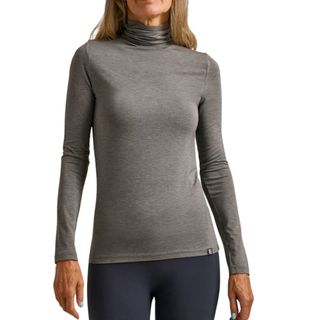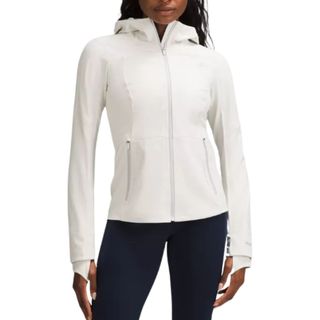Already a walking fan? You're going to love the benefits of Nordic walking. In the past five years, the simple act of putting one foot in front of the other has morphed from something we don't even consider a workout, to being right up there with the likes of Pilates and HIIT as a chosen form of getting our sweat on.
Once the domain of (dare we say it) an older generation, these days, walking workouts literally couldn't be more on-trend, with the likes of 12-3-30 workout and walking pads going wildly viral on TikTok. The benefits of walking are consistently raved about by celebrities, too, with A-listers from Jennifer Aniston and Reese Witherspoon to Oprah Winfrey sharing their love of the low-impact, gentle workout.
And Nordic walking only promises to up the legitimate benefits of a humble hike: studies (like this one, published in the journal BMC Musculoskeletal Disorders) show that it can help reduce lower limb pain, while others (such as this study, from the Journal of Electromyography and Kinesiology) reveal that it boosts core strength, in addition to all the benefits you'd expect from 'normal' walking, too.
While trainers (and science) swear by it, the potential of Nordic walking itself to improve our physical and mental health is relatively untapped - but we predict that it'll soar in popularity as more of us hop on the trend. With this in mind, we've mined the collective knowledge of walking pros to bring you a complete guide to Nordic walking - keep scrolling for everything you need to know.
While you're here, you might want to read our features on the best indoor walking challenges, Senior Health Editor Ally Head's walking pad review and the many walking desk benefits you'll reap if you invest in one. Rather stay inside in the warm? Indoor walking exercises, at the ready.
6 benefits of Nordic walking that'll convince you to give it a go
What is Nordic walking?
So, what exactly is Nordic walking? It won't surprise you to learn that the style of strolling first evolved in Finland as a way for cross-country skiers to maintain fitness during the off-peak season, before becoming more popular across Europe generally around 20 years ago. In a nutshell, it's walking with poles - similar to skiing, minus the snow.
"Nordic walking is a fitness phenomenon that originated in Scandinavia in the 1960s and has gained popularity worldwide for its health benefits," says Carla Khouri, a qualified mountain leader, outdoor instructor, and community lead at Merrell Hiking Club. "It involves walking with poles that resemble ski poles but are designed for walking. The poles provide stability and facilitate a full-body workout by engaging the arms, shoulders and core muscles in addition to the legs. This effectively transforms a simple walk into a comprehensive exercise routine."
How is Nordic walking different to regular walking?
So far, so simple, but if you're wondering how exactly Nordic walking differs from regular walking, you've come to the right place. And, quite honestly, it is pretty similar - with an added boost from engaging the arms as well.
"Conventional walking primarily targets the lower body muscles," notes Khouri. "Nordic walking actively involves the entire body, increasing calorie expenditure and enhancing muscular endurance. The rhythmic motion of the poles promotes better posture and spinal alignment and can reduce the risk of back pain and injury, too."
Put simply, you'll walk as normal, but swing your arms at the same time, driving the poles forward for full-body engagement.
@fieksese ♬ IT GIRL (Sped up Version) - Aliyah's InterludeWho is Nordic walking good for?
Being low-impact, straightforward and (apart from an initial outlay for the poles) free to participate in, Nordic walking is delightfully accessible and can be enjoyed by anyone who likes a good walk but is especially suitable for people who may be injured, those who are just starting out on their fitness journey and older adults.
"Nordic walking is versatile and can be adapted to almost anyone," agrees Khouri. "It’s easy to learn for beginners and offers a low-impact way to get fit. In older adults, it improves balance, strength, and coordination, reducing the risk of falling."
6 benefits of Nordic walking you need to know about
Tempted to give Nordic walking a go? Read on to delve further into the benefits.
1. It's a full-body workout
As touched on above, walking is generally lower-body focussed. The addition of poles in Nordic walking levels up your average walk, turning it into a more full-body activity - great for overall health and fitness.
"Nordic walking is known for mimicking the movements of cross country skiing, and as such is a good full-body workout," explains Nordic walking instructor and personal trainer Jennie Anstell. "The introduction of two poles helps to utilise 90 percent of the body's muscles, ensuring the upper body is given a great workout as well as the legs."
2. It enhances mental health
While there are lots of advantages to home workouts, it's undeniable that exercising in nature enhances the mental health benefits of working up a sweat. Studies show that an outdoor workout can reduce stress, boost self-esteem and lower levels of perceived exertion compared to exercising indoors - plus, if you're a sociable type, there are loads of walking clubs you can join to foster a sense of camaraderie and community, also. Watch those mental health benefits rack up!
3. It's joint-friendly
If you find HIIT a little heavy on your joints, Nordic walking could be the answer. Using the poles means you'll be distributing your weight evenly while walking, reducing the load on individual joints, as well as enhancing balance and stability.
"Nordic walking is a joint-friendly activity that is great for improving mobility, posture and balance," notes health and wellness coach at Vitality, Andrew Isaac. "Not only will the poles allow better posture by keeping the body upright, they can also improve balance and aid in rehabbing any pre-existing injuries, as well as ease joint pain and help with any inclines during the walk."
4. It helps improve core strength
Any activity which challenges your balance will also work your core, as our abs are the body's main stabilising muscles. While walking normally requires a degree of balance, studies show that Nordic walking in particular engages the core more than standard strolling, for increased abdominal strength and stability.
5. It boosts cardiovascular health
All our experts agreed that Nordic walking trumps normal walking when it comes to enhancing cardiovascular output - and the science agrees, with studies showing that Nordic walking can improve cardiovascular health in as little as four weeks.
"Nordic walking is a great way to get the heart rate going and boost cardio health and fitness," agrees Isaac. "Since it allows the body to use more energy than standard walking, over time it will improve both aerobic capacity and muscular strength." Put simply: it'll make you fitter.
6. It improves grrip strength
We've said it before and we'll say it again: don't overlook grip strength as an important marker of overall health and fitness.
Research shows a quantifiable link between how good our grip is and health biomarkers ranging from how likely we are to develop certain diseases, to how long we'll live - and Nordic walking has been shown (in studies such as this one, published in the Journal of Exercise Rehabilitation) to boost non-dominant hand grip and shoulder strength in middle-aged women - win, win.
Shop MC UK's essential walking kit here:

Merrell Women's Moab Speed 2 trail shoes
If you invest in just one walking essential, make it a sturdy pair of shoes. You can't go wrong with a pair of Merrell; these are lightweight, supportive and flexible for whatever terrain you choose.

Brave the elements in warmth and style with this lightweight rollneck from sustainable activewear brand BAM. Soft and perfect for layering under a walking jacket, it's ideal for a January hike.

Lululemon women's Cross Chill Performance jacket
We love this waterproof, windproof jacket for our winter runs, and it's just as good for walking, too. Warm and lined with super-soft fleece, you'll never want to take it off.
How do I get started with Nordic walking?
"If you're a beginner, the first thing you'll need to do is invest in good-quality poles designed specifically for Nordic walking," advises Khouri. "Many communities offer free or low-cost introductory classes to teach proper technique, and proper form is crucial to reap the benefits of the practice.
"Key points include keeping your back straight, planting the poles correctly, and coordinating arm and leg movements. You should also wear comfortable, weather-appropriate clothes and supportive walking shoes, to ensure you're dry, warm and comfortable."




















 English (US) ·
English (US) ·